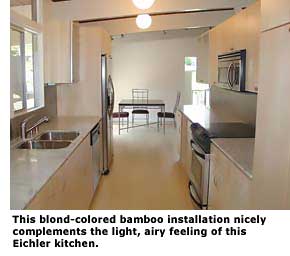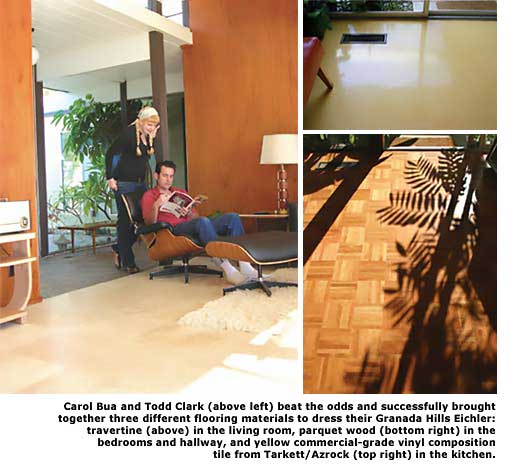Flooring: Top Floors, Best Choices - Page 2
"We liked the look of all of these materials and felt they were appropriate for the era in which the house was built," Bua says. The completed project helped to separate her living spaces and added visual interest, too.
There are so many options available in flooring that choosing the right material can be challenging. From natural materials to synthetics, there are countless color, pattern, and texture selections. "It's very easy to become distracted mid-project, derailing all of the effort you've put into planning," McCullar says. "The challenge is to know when to use restraint in your materials selection, and when to cut loose!"

Materials like bamboo, slate, and limestone on larger-scale applications can be effective choices for a mid-century modern home. Acid-etched and stained concrete floors are also popular.
Ceramic and porcelain tiles are gaining depth in color and dimension with more complex glazing applications and sparkles that mimic natural metal flecks in stone. Although neutrals still reign supreme, some of the newer products are deeper and darker with more gray and blue tones mixed with khaki and browns.
Bigger is better in stone and ceramic flooring tiles, with dealers offering 16-,18-, 20-, and even 22-inch tiles. "The larger tiles allow the homeowner to create a more seamless look with fewer grout lines," said Lori Kirk-Rolley, marketing director of flooring manufacturer Daltile. Large tiles make installation a bit tougher on installers, however, and they can crack if the subfloor (concrete slab, plywood underlayment, or other mounting surface) isn't prepared properly first.
The seamless look is becoming even more important for homeowners who want more continuity in indoor and outdoor looks, extending the same hard surfaces from their kitchen or living areas to the backyard patio. When installing tile, thin grout lines also support this appearance of continuity.
Many designers are seeing use of more rustic and irregular stones that can also be used on interior and exterior surfaces. "They create a wonderful effect when continued through the home and out beyond the glass walls and onto the back terrace," McCullar says. "It really tied the spaces together beautifully."

Planning Tips
10 Things to Consider before Choosing Your New Floor
Flooring is a costly item in the overall picture of a remodel, so whatever material you select needs to suit your lifestyle and your budget. Flooring costs are determined by material and installation costs, which vary among different regions. Consider these points, as suggested by the World Floor Covering Association:
1. No matter how good the flooring you choose, incorrect installation will result in an uneven surface that will wear poorly. Always have flooring installed professionally.
2. Radiant heating under the floor is compatible with most types of hard flooring, particularly ceramic, stone, and many hardwoods. However, before beginning installation over in-slab radiant heat, professionally inspect the health of the system for any possible repairs that may require slab penetration. Secondly, be sure to discuss your radiant heat with the installer; special installation techniques and adhesive materials (that can withstand heat without breaking down) may be in order.
3. Plain-colored flooring shows up marks more quickly than floors with a patterned surface.
4. Think carefully about your selection of materials for furniture, soft furnishings, cabinet finishes, work surfaces, and appliances before making a final decision on the type of flooring. This way you can ensure that all the elements complement one another.
5. The amount of day-to-day maintenance you are willing to undertake may influence your floor choice. Some materials, such as wood, require more care, especially around a sink where water can damage the varnish.
6. Does your old flooring need to be removed? In most applications, with the exception of radiant-heated floors, wood and laminate often can go right on top of existing flooring. Vinyl, linoleum, cork, and tile frequently cannot. Carpet can be laid on almost any surface, although it is easier to install over wood. Check with your flooring installer before purchase. For homes on a slab, be sure to request a moisture test prior to finalizing your flooring choice and installation options; a moisture barrier installation may be necessary.
7. When getting quotes from flooring dealers, be sure the price quotes include all subfloor preparation, all installation costs, removal of existing flooring (if needed), moving furniture and appliances, and all necessary materials for installing your floor.




